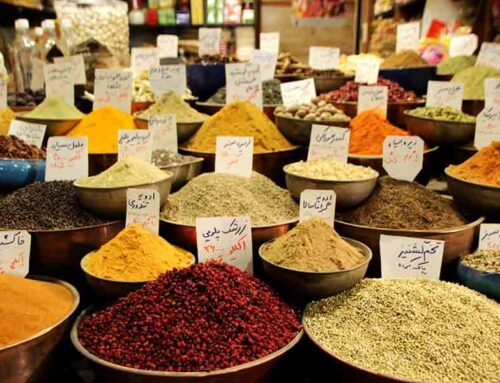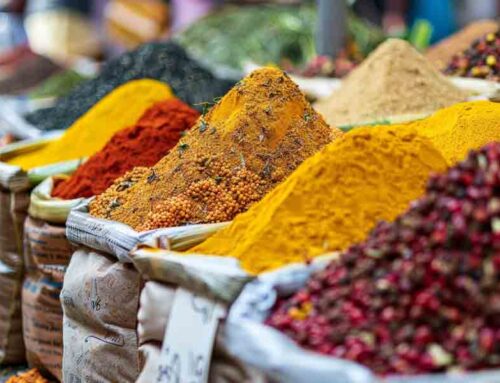Origins of Spices in Ancient India
In the wide landscapes of ancient India, spices were not just culinary components but also had deep spiritual meaning. This is where the fascinating history of spices is revealed. Known as the “Spice Bowl of India,” the Western Ghats are home to a wealth of aromatic treasures such as cardamom, and the vast spice plantations of Kerala are the source of black pepper’s potent appeal. These spices became essential to Indian food, Ayurvedic medicine, and cultural rites, laying the groundwork for a millennium-long gastronomic and medical revolution.
Spice Routes to the Silk Road: A Historical Detour
The Silk Road started to weave complex trade routes that connected India with the Middle East circa 2000 BCE. Through these historic channels, spices such as turmeric, ginger, and cinnamon underwent a metamorphosis and came to represent wealth and prestige. The maritime Spice Routes, which connected India to China, Southeast Asia, and the Mediterranean, gained importance after the fall of the Roman Empire. Spice trade at this time enhanced international cuisine while also promoting cultural fusion and a rich tapestry of tastes from throughout the world.
Exploration in the Age of Wonders: Spice Islands and Beyond
The discovery of Indian spices in the fifteenth century spurred explorers’ zeal for discovery. The Age of Exploration began when renowned explorers like Ferdinand Magellan, Vasco da Gama, and Christopher Columbus set out to find a direct way to the Spice Islands. The flourishing spice trade built a global network that changed economies and brought the unusual, rich flavors of Indian spices to far-off places. The worldwide spice trade, which is still flourishing today, had its roots in this century.
Colonial Impact: Spice Plantations and Trade Dominance
Colonial powers recognized the economic value of spices and sought to control this lucrative trade. This led to the establishment of spice plantations in India by the Dutch, Portuguese, and British. While the colonial era brought prosperity, it also left an indelible impact on the cultural and culinary identity of regions involved. The fusion of Indian spices with European cuisines became a culinary legacy that persists in the diverse and flavorful dishes enjoyed today.
Spice Plantations and Trade Dominance as a result of colonialism
Recognizing the economic potential of spices, colonial nations aimed to dominate this profitable trade. As a result, the Dutch, Portuguese, and British established spice farms in India. Although the colonial era provided affluence, it also irrevocably altered the regional identities in terms of culture and cuisine. Indian spices were combined with European cuisines to create a culinary heritage that is still present in the varied and savoury foods that people eat today.
India is a major player in the modern spice trade.
India is a dominant force in the world’s spice trade in the modern day. India’s fame is mostly due to its flourishing plantations in Kerala, its bustling spice markets in Delhi, and its perfumed plains in Karnataka. Indian producers, distributors, and exporters of spices are essential to satisfying the varied needs of the global market and guaranteeing a consistent flow of high-quality, sensory-appealing spices.
Demand Worldwide: The Insatiable Hungry Taste for Indian Spices
Indian spices are traveling the world, bringing their aromatic depth of flavours to cuisines all over the world. Spices like cardamom, cumin, and coriander are extremely versatile and are used in kitchens all around the world. Indian spices are more than just ingredients; they are cultural ambassadors that give food all around the world complexity and personality. Indian spices are in high demand worldwide as people who enjoy cooking want to improve their culinary adventures.
Difficulties and Sustainability: Managing the Upcoming Years
Even though spices still tell enticing stories, the contemporary spice sector has difficulties. Concerns about sustainability, ethical sourcing, and climate change have led to a change in direction toward responsible methods. Suppliers, producers, and exporters of Indian spices are leading the way in adopting fair trade policies and environmentally responsible projects to preserve this age-old industry. The emphasis on sustainability protects the cultural legacy ingrained in each spice as well as the environment.
In conclusion, relishing the symphony of spices
To sum up, the history of spices is a captivating symphony that has endured over time. Spices have travelled a long and fascinating journey, from ancient marketplaces to contemporary kitchens, through cultural fusion and culinary innovation. India’s producers, suppliers, exporters, and makers of spices continue to be essential players in this worldwide voyage, making sure that every spice has a backstory and every meal has a rich and flavourful legacy. Kisan Agro invites you to participate in this enduring culinary symphony as you enjoy the flavours of spices that have crossed continents.
Contact us with any questions or to start your journey toward a spice-filled food.



